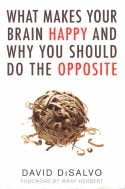
Prometheus Books, ISBN 978-1-61614-483-8
Swimming against the toxic tide of baseless “self-help” books, DiSalvo offers us a “science-help” book, and a very generous offering it is, too. His metaphor of the “happy brain” refers to our evolved tendencies to avoid loss, reduce risk and avert harm, valuable predispositions which can be triggered in inappropriate ways in many everyday contexts. He suggests ways that we can counteract these leanings, once we recognise that they are there.
Central to this mental machinery is the brain’s homeostasis, experienced as unease or anxiety in the face of ambiguities or direct challenges to the schemata we use for thinking and navigating our way through life. Reducing this unease in the face of awkward new information can take the form of ignoring, blocking or belittling the data in question.
Familiar stuff, no doubt, to skeptics. What distinguishes this book is the effort DiSalvo has put in to make his book useful: to make the insights of research practicable. One of the chapters is a toolbox of usable knowledge, in the form of a compilation of fifty practical suggestions, rules and hints. He also provides an annotated bibliography and list of online resources. There is, of course, a proper index, something that Pan Books, the publisher of Richard Wiseman’s comparable 59 Seconds, lamentably failed to provide.
Among the recommendations are: make goals tangible and measurable; become savvy about framing; make checklists and use them; be on the lookout for regret manipulation; practise for the purpose.
Of particular interest is the idea that “your brain is not only in your head”, or, as DiSalvo refers to it, the theory of embodied cognition. Twenty-odd years ago, Stephen Priest, in Theories of the Mind, described the empiricist theory of the mind as being “the identification of the brain with that which engages in the activity of thinking”. DiSalvo follows this kind of anti-dualist line, saying that the mind is “what our nervous system does”, but reports that the theory of embodied cognition extends this conception beyond what we might normally conceive as thinking. This has also been explored philosophically by Mark Rowlands, in Externalism and other books, and helps further the project of constructing an expanded vision of how humans think and feel, and how we can get beyond antique notions of “the mind”.
Packed with fascinating insights and engagingly written, this book is warmly recommended.
Paul Taylor



